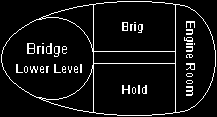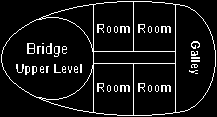Introduction to the "Alis"


The Alis is the latest spacecraft designed by Wren, and the first not to be named "Landale." Compared to the infamous Landale I it is a diminutive craft, but it is undeniably the fastest and most fuel efficient of all.
Unlike previous ships, Alis is designed for optimal maneuvering in both the vacuum of space and within the confines of a planetary atmosphere. Its air circulation, water recycling, artigrav, and other systems are based upon those first used in the construction of Palm II. The ship is divided into two decks. The upper deck is where the galley and crew quarters are located. The ship's hold, brig, and engine room are all on the lower level. Two transtubes connect the two decks, with one being on each end of each deck.
The bridge is shaped like a hollow column, with the main bridge floor being on the lower deck. This is where the vital navigational and communication systems are located. Non-vital control stations are located on a "catwalk" that circles around the upper half of the bridge. The two levels are connected by an elevator. There is also a ladder in case of catastrophic loss of power.
Although simplistic in design, Alis is designed to be comfortable by Palman standards. The bridge and connecting hallways of the ship have only featureless stainless steel walls, floors, and ceilings. However, the crew cabins have lush dark teal carpeting, twin single beds, two small desks, a chair for each desk, a lounge chair, and a small round table complete with two chairs of its own. All of the furnishings are made of hard wood and extensively padded and cushioned. There is also a large view port and an attached full bathroom for each cabin. All cabin lighting is concealed and kept soft.
The ship's galley is optimally designed for less than five crew members but can accommodate as many as eight people with relative efficiency. The galley is divided into two sections: a small kitchen and a somewhat larger dining room, both complete with all possible conveniences.
Alis, like Landale I, Landale IV, and Landale V, is designed with lengthy interstellar travel in mind. All of the ship's environmental mechanisms can run for as long as two years without any maintenance due to the advanced recycling and autorepair systems, the latter of which being based on android recovery units. The ship's hold has room for enough supplies to last a years-long voyage, and is always kept fully stocked. The brig contains three cells, each with its own bed, sink, and toilet.
The technological leap from Landale XI to Alis represents the greatest degree of improvement from one of Wren's ships to the next.